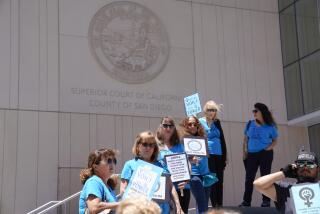Before we open the cell doors
- Share via
Earlier this month, a panel of three federal judges issued a tentative ruling that California must reduce its state prison population by more than 55,000 to relieve intense overcrowding and poor medical and mental health care.
If the order holds, the state will have to figure out how to release prisoners on a scale never before seen. Joan Petersilia, professor of criminology, law and society at UC Irvine and the author of “When Prisoners Come Home,” spoke about the ruling and its potential effects with Opinion page contributor Sara Catania. What follows is an edited transcript of their conversation.
--
Is there a precedent for an early release of this magnitude?
Never on the scale we’re talking about here. The most dramatic example occurred in Illinois in the 1980s, when the state released 1,200 people early.
--
Did crime increase as a result?
No, but there are crucial differences in the circumstances of the Illinois release and the proposed California release. In Illinois, the total number of prisoners released was a fraction of what we’re looking at for California. The Illinois numbers were low enough that if all the released prisoners were rearrested, it probably wouldn’t affect the state’s overall reported crime rate. Illinois also had some ability to limit releases to lower-level offenders.
--
Do you think early release can work in California?
I’m in favor of early release at a lesser level. I think we could safely release 15,000 to 18,000 prisoners. That would include very low-level technical parole violators, the elderly and low-level drug offenders. Nearly everyone who has studied this issue recommends removing less serious parole violators from state prisons.
--
How does the poor economy affect early release?
In two primary ways. First of all, whether you are conservative or liberal, everyone agrees that we don’t want to be spending $46,000 a year to house a prisoner who represents no public safety risk when it takes about $12,000 a year to fund a really good community-based program for that person.
Unfortunately, the services these former prisoners would need revolve primarily around substance-abuse treatment, and those are exactly the programs that are being cut. Limited early release is a good idea, but it could not be happening at a worse time. Just opening up prison doors and releasing 55,000 prisoners with no preparation is harsh to the offender and dangerous to the public.
--
Is there an early release approach that might mitigate the fallout?
Yes. In 1994, California’s Legislature created the Community-Based Punishment Act. It was never funded, but now people are talking about reactivating it. Under the act, if you’ve got prison-bound parole violators and you’re willing to keep them locally rather than sending them to state prison, you get a kickback from the state to pay for programs to ease their reentry into society. This approach could include short-term incarceration, intensive supervision, house arrest with electronic monitoring, enrollment in a work-release program, day reporting and mandatory substance-abuse treatment.
In our prisons, the overcrowding crisis is caused by parole violators returning to prison. Every year, we send some 70,000 parolees back to prison, about 30,000 of those from L.A. County alone. Most serve two to three months. Everybody knows this revolving door does not protect the public and in fact puts it at greater risk. These are the lower-level people who may have been in drug treatment, may have found a job and housing. When you send them back to prison, you break those connections and destabilize them. A few months later, they’re back on the street and expected to start all over again.
--
You recommend a far more limited early release than the one being proposed. Is it possible to do the release right with four times as many prisoners than you recommend?
No, not with the way California currently operates its prison and parole system. If we start releasing prisoners in such high numbers, those who are released are bound to include prisoners with lengthy criminal histories and violence in their backgrounds.
The best way we can reduce the risk these more serious prisoners represent is to transfer them from prison to intensive residential reentry facilities, or perhaps to electronic monitoring and house arrest. Once there, parole agents and community providers would need to closely monitor the prisoners’ behavior and try to interest them in rehabilitation and work training. Simply releasing this larger group of prisoners without the necessary housing and services is asking for more crime.
--
Is anyone talking about how to pay for the community approach, or are already overworked probation and parole officers just going to have bigger caseloads?
There is a lot of discussion going on in Sacramento about how to fund “intermediate sanctions” to be used instead of sending someone back to prison. If a prisoner who violates parole, for example, no longer returns to prison but remains in the community, who is responsible for his surveillance and services? We can’t ignore their parole failures because often those failures are a signal that the parolee is slipping. Other states have used intermediate sanctions, such as those described in the Community-Based Punishment Act. But in order to employ this model, we have to provide money to counties to expand these types of intermediate sanctions. If we can transfer the state prisoner to a community-based program, we save money -- and perhaps more important, provide services that might actually help the prisoner stay out of crime in the long run -- which, of course, saves even more money.
--
Even if early release went according to the best possible plan, there will still be the same number of cells and the same level of administration. Will there really be much in the way of savings inside prisons?
No, we won’t see any cost savings immediately. If prisoners are released, the remaining prisoners will simply spread out so as to not be as crowded, thereby satisfying the court’s requirements.
Of the $46,000 we spend a year to house a prisoner in California, $2,500 goes to food and clothing, $9,000 goes to healthcare and $2,000 goes toward education and employment training to prepare the inmate for release. That’s a total of $13,500 per prisoner. More than two-thirds of the cost of housing an inmate in California goes toward security and operations, making the overall cost of housing a prisoner in California the highest in the nation. There are no plans to close prisons any time soon, so the cost of running the prison system will remain rather unchanged for quite some time.
--
If the early release order is enacted on the scale proposed, there is a risk of a high level of recidivism, which carries a hefty price tag. In the end, will any money be saved?
The key to all of this -- the real money -- is in the California prisons, to the tune of $10 billion a year. If we’re to solve the state’s prison crisis, we’ve got to figure out how to shift some of that away from state prisons and into local programs. If we don’t, we’re setting the system up for failure.
Without sufficient financial support, we’re going to release these people and they’re going to fail. You’ll wind up with another victim, plus the cost of the prisoner’s reincarceration. If we don’t do this right, all of these people will be back in prison. We will have saved in the short term, but the long-term consequences will be huge.
More to Read
Sign up for Essential California
The most important California stories and recommendations in your inbox every morning.
You may occasionally receive promotional content from the Los Angeles Times.










